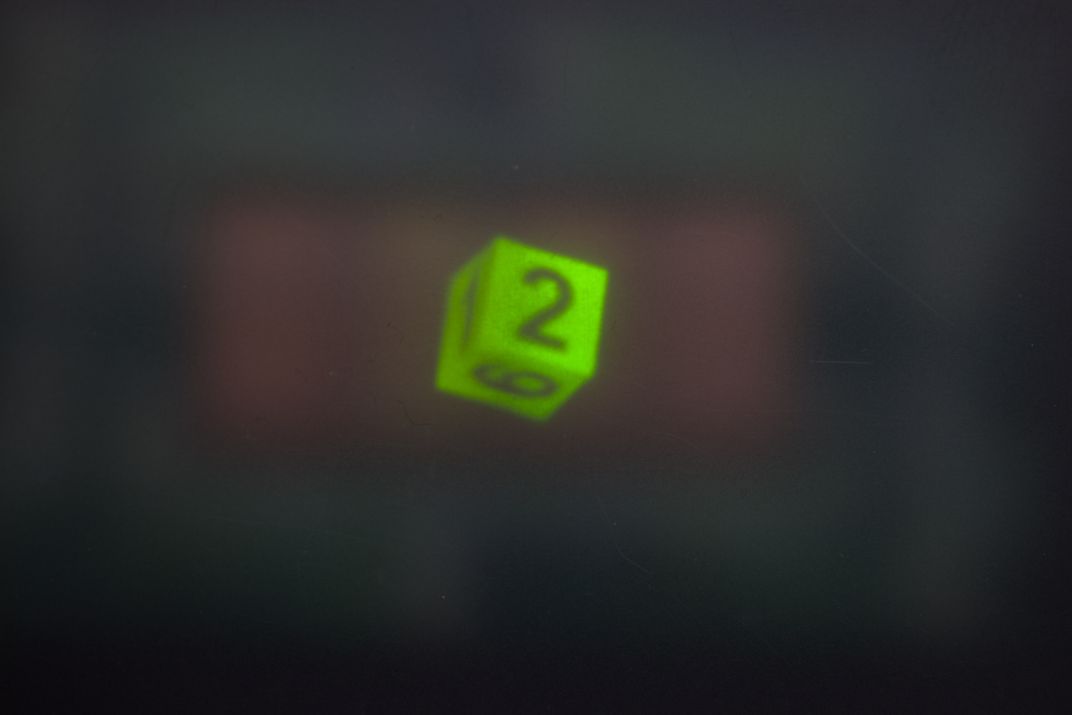Your Smartphone And Sunglasses Could Soon Project Holograms
A chip the size of a TicTac can project images, in 2D or 3D, from everyday objects.
/https://tf-cmsv2-smithsonianmag-media.s3.amazonaws.com/filer/56/56/56560bf3-373c-453b-a416-f8c79b6f6499/image_projection_on_qpi.jpg)
Imagine a future in which wearing a device didn’t make you a walking eyesore (yes, we’re looking at you, Google Glass).
Part of that future came into focus last week, as the California-based Ostendo Technologies showed The Wall Street Journal a display chip that can project crisp images—in both 2D and 3D—when built into a phone, a tablet, a pair of glasses or anywhere else you might normally have a flat display.
The Quantum Photonic Imager (QPI) imager chip, smaller than a Chicklet, is attached to a miniature projector; together, they can be embedded in a variety of mobile devices to bring anything from advertisements to images to life. A smartphone could project an image above its screen, for instance; the contents of a website could be bounced from a chip embedded in the arm of a pair of glasses onto its lenses.
The QPI chip comes at a time when major tech companies are all in hot pursuit of virtual and hyper reality. Facebook recently purchased Oculus Rift, a company credited with the biggest breakthrough in virtual-reality goggles to date. Amazon is rumored to be working on a phone that uses a multi-camera system to make its display appear 3D; Apple has even filed patents that hint at future 3D displays.
The pursuits are bringing to small devices what we've been seeing in things like museums and events for years. Microsoft has demonstrated a full holographic presentation room and there’s an entire holographic museum in Queens, New York; San Diego company AV Concepts famously projected an image of the late rapper Tupac Shakur at Coachella in 2012—and let's not forget the holographic Michael Jackson at this year's Billboard Music Awards.
One of the biggest challenges facing wearable displays, like the one on Glass, though, has been that the internal components are too large to be hidden. Ostendo says it has spent the past eight and a half years quietly developing the QPI image engine to be both compact and high in resolution.
The 5-by-5-millimeter chip contains an image processor, micro LEDs and image-rendering software. To produce an image, the processor controls the precise distance and angle of each of those LEDs. The images are higher in resolution than those produced by most current phone screens. A QPI image has 3,000 dots per inch; a Samsung Galaxy S IV has 441.
A single QPI module can either project a 2D image or create a small 3D hologram. (For the latter, the Princess Leia references are unavoidable.) Companies could also connect several modules together to create much larger images.

Ostendo says it ultimately wants to embed its chips anywhere there would normally be a display, including storefronts or even our living rooms.
It's a lofty goal. But Ostendo, which means “to show” in Latin, comes with the pedigree needed to make that dream a reality. Founder and CEO Hussein El-Ghoroury served as Executive Vice President of Linkabit Coroporation, the company that would later become Qualcomm, and was the founder of CommQuest Technologies, a company that pioneered the first quad-band cellular chipset in North America and is now owned by IBM.
The company, which has more than 100 patents to its name, has raised more than $90 million in venture capital for this and other projects. Investments include monies from early Facebook funder Third Wave Ventures. Forty million of that sum came from DARPA, the Defense Department’s technology development arm, the company says.
El-Ghoroury told the Wall Street Journal that the company is already in talks with a few smartphone manufacturers. The chips should cost about $30. First to market sometime next year will be a 2D–capable projector chip, with its flashier hologram-producing cousin following shortly thereafter.
/https://tf-cmsv2-smithsonianmag-media.s3.amazonaws.com/accounts/headshot/me.jpg)
/https://tf-cmsv2-smithsonianmag-media.s3.amazonaws.com/accounts/headshot/me.jpg)